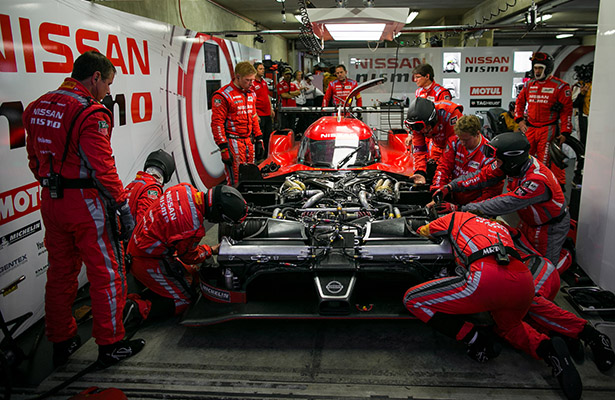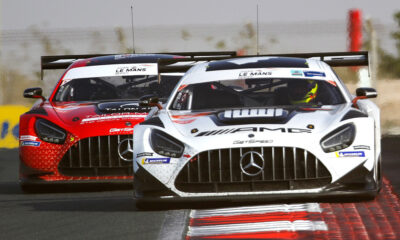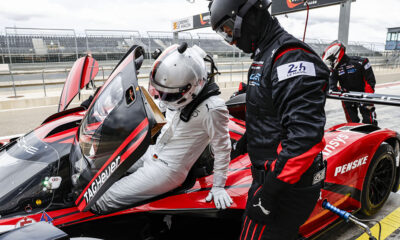
Photo: Nissan
Nissan’s global motorsports boss Darren Cox has confirmed that all three of the Nissan GT-R LM NISMOs did not run with its hybrid systems engaged during the 24 Hours of Le Mans, while a decision has yet to be made on whether it will enable the KERS system for remainder of the FIA World Endurance Championship season.
The Japanese manufacturer struggled in its LMP1 debut last weekend, with two of the front-engined, front-wheel drive cars retiring and the No. 22 entry of Harry Tincknell, Michael Krumm and Alex Buncombe taking the checkered flag, but not being classified after spending nearly one-third of the race in the garage.
“Obviously the two biggest issues we had was that we didn’t engage the KERS system, which had a knock-on effect in a number of areas, including braking and fuel consumption as well,” Cox told Sportscar365. “We were losing 2 MJ of power around the circuit, so you had to get the power from somewhere else.
“The one we weren’t expecting was the inability of the car to run the harsh curbs, which meant we had to keep the drivers off the curbs. You lose a significant amount of time not able to do that. But it was the right thing to be conservative as we didn’t want all three cars to be out with suspension issues early on.”
As a result of the conservative approach, Cox said the cars failed to set representative times, with Tincknell’s 3:35.888 lap being the quickest of the Nissans, although more than 18 seconds off the pace from the pace-setting Porsches and Audis.
“It had a negative spiral on lap times,” he said. “You could probably work out how much time we were losing in each corner but it was a decision to rack up a number of miles that we needed with the car.
“It was a tough weekend for everyone. Everybody in the garage is a racer. To have to make the decision to effectively test on the weekend and not compete was very painful. But it was the right thing to do.”
Cox said the decision to disable to hybrid system, which is mandatory for all factory LMP1 teams, was made due to reliability concerns with the 2 MJ unit.
“It was going to cause us more problems than benefit,” he said. “It was too [big of a risk] to switch it on.
“That’s obviously something we’re going to go in a very different direction for 2016.
“It’s something we have to work on for the other races [this year] as well because it has a knock-on effect in other areas of the car’s performance.”
He said a decision has yet to be made on whether they’ll enable the hybrid system for the remaining FIA WEC rounds this year, although the cars would still run with the units on board, per LMP1 rules.
A number of developments are planned between now and the fourth round of the season at the Nürburgring in August, including its high-downforce aero package, as well as fixes to both the suspension and brake issues that plagued the cars at Le Mans.
“Clearly we’ve got to do some upgrades to the suspension, which was already planned,” Cox said. “Then we go from there and work on some other elements. We’ve also got to make sure our brake cooling is up to scratch.
“In a way, the hybrid becomes a secondary issue. We’ve got to make the car work, fundamentally.”
All three cars will return to the U.S. for updates and a two-day test scheduled at the end of July, with the third GT-R LM NISMO turning into its test and development car for 2016.
Cox said they’ll continue with three-driver lineups in both cars for the remainder of the season, but have yet to determine the third drivers for the German round.

























